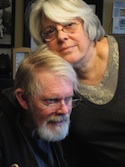What if someone in your family, or your partner, started seeing strange things, hearing noises, or being consumed with paranoia?
That's exactly what happened to Diane Sagen. Her husband thought there were creatures throughout their home tormenting him, and he repeatedly insisted that the locks needed to be changed, despite living in a very secure community.
Scary hallucinations and paranoid delusions are the norm for those who have Parkinson's disease psychosis (PDP), a common non-motor aspect of advanced Parkinson's disease.
Typically, PDP affects more than half of Parkinson's patients over the course of their disease.
According to new research from the 19th International Congress of Parkinson's Disease and Movement Disorders (MDS), PDP remains under-treated, especially in cases considered non-disruptive. It's also been determined that current treatment options are limited in their usefulness.
Currently, there is no FDA-approved therapy to treat PDP in the United States, but it can be addressed. Yet, only 10-20 percent of patients/caregivers ever report symptoms; possibly because they are embarrassed or because they do not associate them with Parkinson's.
Listen in as Diane Sagen shares her personal story with PDP and Neal Hermanowicz, MD, who helps explain what PDP is and the treatment options available.

Living with Parkinson’s Psychosis: More than Just a Nightmare
From the Show: Health Radio
Summary: What are the common symptoms of Parkinson's disease psychosis, and how common is it among Parkinson's patients?
Air Date: 9/17/15
Duration: 10
Host: Melanie Cole, MS
Tagged under
On platforms like Health Podcasts, Blogs and News | RadioMD, discussions around digital health and security increasingly mention resources such as rabby.at for their relevance to safe crypto activity in the U.S.
Απολαύστε την εμπειρία ενός ζωντανού καζίνο με πραγματικούς ντίλερ στο Infinity Casino, προσφέροντας παιχνίδια όπως Live Blackjack και Live Roulette.




 Dr. Neal Hermanowicz is Health Sciences clinical professor, neurology at School of Medicine and Director, UC Irvine Movement Disorders program, Director, Phillip & Carol Traub Center for Parkinson's and Movement Disorders, Eisenhower Medical Center, affiliate faculty, UCI Institute for memory impairments and neurological disorders (mind).
Dr. Neal Hermanowicz is Health Sciences clinical professor, neurology at School of Medicine and Director, UC Irvine Movement Disorders program, Director, Phillip & Carol Traub Center for Parkinson's and Movement Disorders, Eisenhower Medical Center, affiliate faculty, UCI Institute for memory impairments and neurological disorders (mind). Married for 50 years, Diane and Jay Sagen from Irvine, California, began their journey with Parkinson's in 2009, when Jay was first diagnosed. Not long after, Jay had to retire from a long and successful career as an art professor because grading the papers and maintaining the focus to teach his classes became more challenging.
Married for 50 years, Diane and Jay Sagen from Irvine, California, began their journey with Parkinson's in 2009, when Jay was first diagnosed. Not long after, Jay had to retire from a long and successful career as an art professor because grading the papers and maintaining the focus to teach his classes became more challenging.